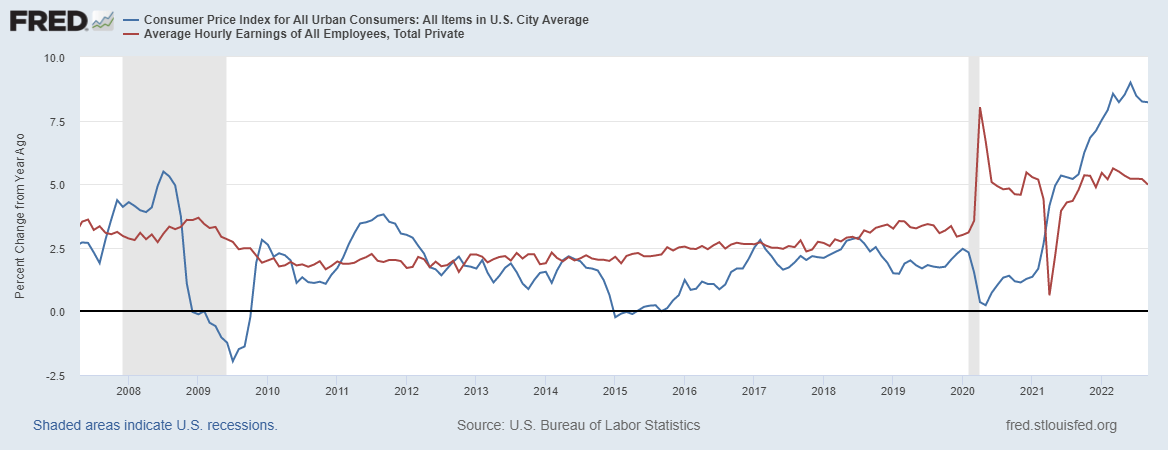coldsnowstorm
A majority of U.S. employed consumers continue to find it difficult to keep up with the pace of inflation that’s running at a four-decade high, hence 65% of employees lived paycheck-to-paycheck in September versus 60% a year ago, according to a recent LendingClub survey, which inquired 3,942 consumers between September 9-23.
Indeed, the mismatch between inflation and wages is quite stark. In September, headline inflation rose 8.2% Y/Y while average hourly earnings increased just 4.9%, as seen in the chart below. In turn, 26% of the survey respondents said they have more than one job, and 30% of workers reported they’re likely to switch jobs over the next six months to receive higher pay.
“With inflationary pressures not expected to subside anytime soon, living paycheck to paycheck has become the norm,” said Anuj Nayar, LendingClub’s financial health officer. “Many are pessimistic about their odds of increasing their paycheck by switching jobs and some households will become more vulnerable to swings in labor market conditions. This could cause many to struggle with the upcoming Holiday season.”
And as the Federal Reserve struggles to push back inflation pressures, consumers believe it will take until mid-2024 for the central bank to be successful, the survey showed, potentially paving the way for continued, if not increased, paycheck-to-paycheck living situations in the near term. Furthermore, 62% of all consumers assume a recession will take hold in less than a year, and 48% think the U.S. is already in a downturn, signaling their grim sentiment.
As the percentage of money-strapped employed consumers grows in the wake of persistently high inflation, it’s likely that they’re falling behind on retirement savings. Bankrate analyst Greg McBridge supported that view with a survey conducted between Sept. 21-23, saying 55% of working Americans felt they failed to contribute to their retirement savings (401(K) accounts) fast enough.
“Workers who are not contributing more to their retirement accounts this year overwhelmingly point to inflation as the reason why, and by more than a 2-to-1 margin over any single response, McBridge said.
One would think that heightened consumer prices combined with a tighter money environment and growing recession risks would result in slower (inflation-adjusted) consumer spending, however, that doesn’t fully appear to be the case in the eyes of some of the largest financial institutions. During Bank of America’s (BAC) Q3 earnings call, CEO Brian Moynihan highlighted that “consumers continue to spend at strong levels.”
As such, consumer spending of $3.1T climbed 12% year-to-date in Q3, he added, noting that transactions gained in single digits Y/Y. The fact that transactions increased partly dismissed the notion that inflation boosted consumer spending entirely. “We just don’t see [slower spending growth] here at Bank of America.”
Payments giant Mastercard (MA) CEO Michael Miebach, similarly, said “consumer spending remains resilient,” after releasing Q3 results that slowed from Q2 levels. Rival Visa (V) cited continued strength in consumer payments as payments volume rose 10% Y/Y in constant dollars.
Looking at macroeconomic data, September’s personal spending growth rose more than expected at +0.6% M/M, while the personal savings rate hovered around its lowest point since 2008, at 3.3%, as fiscal stimulus dries up.
Previously, (Oct. 28) consumer sentiment ticks up from September, inflation expectations stay elevated.
Image and article originally from seekingalpha.com. Read the original article here.


